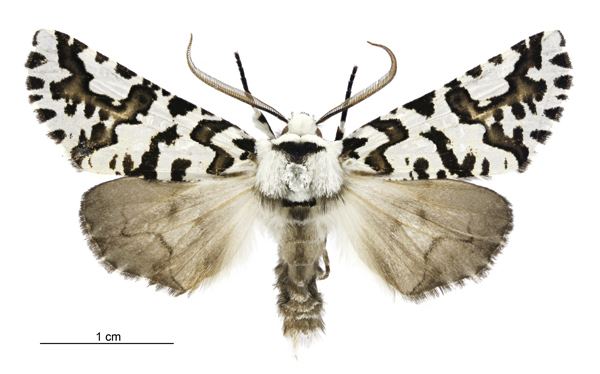Kingdom Animalia Class Insecta Family Geometridae Rank Species | Phylum Arthropoda Order Lepidoptera Genus Declana | |
 | ||
Similar Declana, Puriri moth, Aenetus | ||
Declana atronivea, commonly called the North Island lichen or North Island zebra moth, is a moth of the family Geometridae. It is endemic to New Zealand.
Contents
Taxonomy
D. atronivea was first described by Frances Walker in 1865 as Detunda atronivea.
Description
The larvae have a lumpy appearance and are brown and brownish-white in colour. In the early stages of their life they look similar to a bird dropping when curled on a leaf. They grow to be approximately 30mm long. When an adult D. atronivea has a wingspan of between 40-45mm. This moth is white with dark brown or black markings. It is very similar in appearance to its close relation the South Island lichen moth, Declana egregia, however it has fewer dark markings and does not have the dark edges on the forewing. This gives D. atronivea a more mottled appearance. D. atronivea has a black rectangular mark on the back of the thorax.
Distribution and habitat
D. atronivea is found in the North Island and in 1913 was regarded as being rare in Whanganui region but was noted as being very common about Mount Taranaki and Mount Ruapehu. It has also been found in Wellington, Otaki and Napier.
Life stages
The eggs of D. atronivea are laid from the end of October. They are oval in shape, slightly roughened on their surface and start out green in colour, turning a light blue shade covered with purple spots after approximately a week and then to a light purple colour just prior to hatching. The eggs are laid singularly and hatch after 11 days. Although the larvae are generally brownish or blackish green in colour they can vary in shade significantly. The pupae inhabit a light coloured cocoon which they form amongst leaves on the surface of the ground. The adults emerge in February and March. Some overwinter as pupae while others transform into adult moths.
Host plant
The host plants of the caterpillars of D. atronivea are Pseudopanax including Pseudopanax arboreus and Pseudopanax crassifolium.
